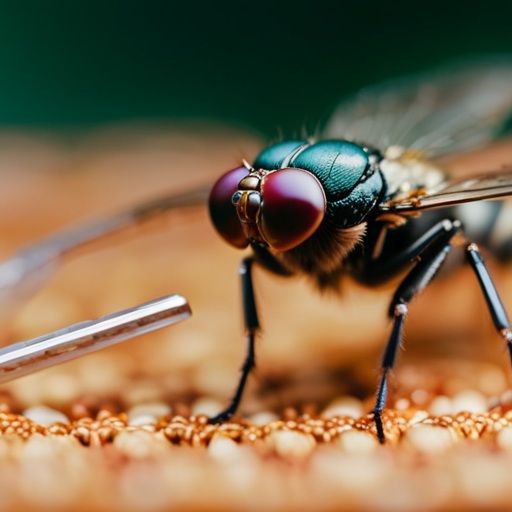Like a squadron of skilled anglers casting their lines in unison, collaborative fly tying projects and events bring together the expertise and creativity of fly fishing enthusiasts.
In this article, we will explore the benefits of collaborative fly tying, various types of tying events, and how to find and host these gatherings.
Whether you are a seasoned tyer or a beginner, join us as we unravel the art of collaborative fly tying and its role in fostering a vibrant fly fishing community.
Benefits of Collaborative Fly Tying
The benefits of collaborative fly tying include the opportunity for skill exchange and the fostering of a sense of community among fly tyers. Building relationships within the fly tying community is essential for the exchange of knowledge and techniques. When fly tyers come together to work on collaborative projects or participate in events, they have the chance to share their skills and learn from one another. This skill sharing not only enhances the capabilities of individual fly tyers but also strengthens the community as a whole.
Moreover, collaborative fly tying provides a platform for building lasting relationships. By engaging in shared activities and working towards common goals, fly tyers develop a sense of camaraderie and mutual respect. These interactions often extend beyond fly tying, leading to friendships and professional connections. The supportive environment created through collaborative fly tying endeavors fosters a sense of belonging and encourages continued participation in the craft.
Ultimately, the benefits of collaborative fly tying extend beyond the finished flies; they encompass the relationships formed and the knowledge exchanged, enriching the experiences of fly tyers.
Types of Collaborative Tying Events
One common type of collaborative tying event is the fly tying competition, which provides an opportunity for fly tyers to showcase their skills and learn from one another in a competitive yet supportive environment. These events often bring together enthusiasts who are passionate about the art of fly tying and create a platform for healthy competition and skill-sharing.
Other types of collaborative tying events include:
-
Virtual collaborations, where fly tyers from different locations come together online to tie flies, share techniques, and engage in discussions about fly tying.
-
Fly tying competitions that are held in person, allowing participants to interact face-to-face and foster a sense of camaraderie within the fly tying community.
-
Community outreach programs that involve organizing group fly tying sessions to introduce beginners to the craft and promote the art of fly tying within local communities.
-
Specialized tying events focused on particular fly patterns, materials, or techniques, providing a platform for enthusiasts to delve deeper into specific aspects of fly tying.
-
Themed tying events that revolve around specific themes or conservation efforts, encouraging fly tyers to create flies that align with the chosen theme or cause.
These collaborative tying events serve as valuable opportunities for fly tyers to connect, learn, and contribute to the vibrant fly tying community.
Finding Collaborative Tying Opportunities
To discover collaborative tying opportunities, fly tyers can explore various platforms and organizations that host events and facilitate connections within the fly tying community. One such opportunity is virtual tying meetups, which have become increasingly popular. These virtual gatherings allow fly tyers from different locations to come together and tie flies in real-time using video conferencing platforms. By participating in virtual tying meetups, fly tyers can learn new techniques, share tips, and connect with others who share their passion for fly tying.
Another way to find collaborative tying opportunities is through partner tying challenges. These challenges involve pairing up with another fly tyer to create flies based on specific themes or criteria. Partner tying challenges not only provide an opportunity for collaboration but also encourage creativity and skill development. They can be organized by fly tying clubs, online forums, or social media groups dedicated to fly fishing and tying.
Tools and Materials for Group Tying
As we explore the topic of tools and materials for group tying, it’s important to consider the benefits of sharing tying stations and making bulk material purchases.
These practices not only foster a sense of community among fly tyers but also offer cost-saving advantages. When participants pool their resources and collaborate on material acquisitions, it can lead to a more efficient and enjoyable tying experience for all involved.
Sharing Tying Stations
The sharing of tying stations, including tools and materials for group tying, is a key aspect of collaborative fly tying projects and events. Effective management of tying stations enhances the overall experience, encouraging a seamless flow of ideas and techniques. Consider the following key points for sharing tying stations:
- Tying techniques: Encourage the exchange of tying techniques and tips among participants to foster a collaborative learning environment.
- Group dynamics: Maintain a balance between individual and group work to ensure everyone’s involvement and a sense of collective accomplishment.
- Material sharing: Facilitate the sharing of materials to allow for experimentation and creativity in fly patterns.
- Space organization: Implement an organized layout to optimize space and ensure easy access to tools and materials for all participants.
- Tool maintenance: Establish a system for maintaining and sharing tying tools to promote efficiency and productivity.
Transitioning into the subsequent section, efficient sharing of tying stations paves the way for cost-effective bulk material purchases.
Bulk Material Purchases
Efficiently coordinating bulk material purchases for tools and materials used in group tying projects is a critical aspect of ensuring cost-effectiveness and resource availability.
Bulk material sourcing offers cost-sharing benefits, enabling participants to access high-quality materials at a lower cost per unit. By pooling resources, fly tying enthusiasts can leverage their collective purchasing power to secure discounts from suppliers.
This approach not only reduces individual expenses but also ensures that essential materials are readily available for group tying events. Moreover, it promotes a sense of community and collaboration among participants, fostering a supportive environment for sharing knowledge and techniques.
Coordinating bulk material purchases also allows for better inventory management, minimizing waste and optimizing the use of resources. Ultimately, this approach enhances the overall efficiency and sustainability of group tying projects.
Tips for Hosting a Group Tying Session
When hosting a group tying session, it’s important to plan engaging tying activities that cater to the skill levels and interests of the participants.
Organizing the materials and space in a clear and accessible manner can help facilitate a smooth and enjoyable tying experience for everyone involved.
Engaging Tying Activities
As a host of a group tying session, you can create an engaging and enjoyable experience for participants by carefully planning the activities and ensuring a welcoming environment. Here are some tips to help you host a successful group tying session:
- Provide clear and easy-to-follow instructions for beginners
- Encourage experienced participants to share their tips and techniques
- Promote a sense of community by fostering a supportive and inclusive atmosphere
- Incorporate fun challenges or themed tying activities to keep participants engaged
- Offer opportunities for participants to showcase their finished flies and share their experiences on social media or local fishing forums
Organizing Materials and Space
To ensure a successful group tying session, meticulous organization of materials and space is essential for an enjoyable and productive experience for all participants. Maximizing efficiency in material accessibility and storage solutions is crucial.
Arrange workstations with clear, labeled bins for feathers, hooks, threads, and other materials. A central table for shared tools and equipment can streamline the tying process and foster collaboration. Additionally, consider implementing a designated space for finished flies to prevent clutter and ensure a systematic workflow. Adequate lighting and comfortable seating are also pivotal for sustained concentration and creativity.
Collaborative Project Ideas
One may consider organizing collaborative fly tying projects to foster creativity and skill sharing within the fly fishing community. Collaborative projects offer an opportunity for fly tyers to come together, share ideas, and learn from one another.
Here are some collaborative project ideas to consider:
-
Fly Tying Challenge: Organize a challenge where participants have to tie flies based on specific creative themes such as ‘insect-inspired patterns’ or ‘holiday-themed flies’. This encourages participants to think outside the box and share their unique interpretations.
-
Online Fly Tying Workshops: Host virtual workshops where fly tyers can join in from different locations to learn and tie flies together. This allows for a broader participation and sharing of techniques.
-
Community Fly Tying Mural: Collaborate on a large fly tying mural where each participant ties a specific section of the mural, which is then assembled and displayed in a prominent location.
-
Collaborative Fly Box: Create a communal fly box where each participant contributes a few of their favorite fly patterns. This allows for a diverse collection of flies and promotes knowledge sharing.
-
Fly Tying Exchange Program: Organize a program where participants tie multiple copies of their favorite patterns and exchange them with other participants. This allows everyone to expand their fly collection and learn new patterns.
Engaging Beginners in Group Tying
Engaging beginners in group fly tying sessions can provide a supportive environment for novices to learn and enhance their skills, fostering a sense of camaraderie and knowledge exchange within the fly fishing community. Interactive demonstrations and hands-on workshops can be instrumental in introducing beginners to the art of fly tying. Beginner-friendly tutorials and group participation allow novices to gain practical experience while receiving guidance from experienced fly tyers. By participating in group tying sessions, beginners can observe different techniques, ask questions, and receive immediate feedback, accelerating their learning process.
Creating an inclusive and welcoming atmosphere is essential for engaging beginners in group tying. Encouraging group participation and providing opportunities for individuals to share their experiences and insights can enhance the learning environment. Moreover, incorporating interactive demonstrations and hands-on workshops can further engage beginners and help them develop their skills more effectively.
Transitioning into the subsequent section about ‘promoting community through fly tying events’, it is evident that engaging beginners in group tying not only fosters individual skill development but also contributes to the overall sense of community and collaboration within the fly fishing community.
Promoting Community Through Fly Tying Events
By fostering a sense of camaraderie and knowledge exchange, fly tying events promote community within the fly fishing community. These events provide a platform for individuals with a shared passion for fly tying to come together, fostering a sense of community bonding and mutual support. Through these events, participants have the opportunity to network and build lasting relationships with like-minded individuals, contributing to the growth and sustainability of the fly fishing community.
-
Knowledge Sharing: Fly tying events offer a space for experienced fly tyers to share their expertise and techniques with newcomers, fostering a culture of learning and skill development.
-
Community Building: These events contribute to the creation of a strong and interconnected fly fishing community, where individuals can find support, encouragement, and friendship.
-
Promoting Tradition: By bringing individuals together to celebrate the art of fly tying, these events help preserve and promote the rich tradition and heritage of fly fishing.
-
Inspiration and Creativity: Participants can draw inspiration from each other, leading to the development of innovative fly patterns and tying methods.
-
Collaborative Projects: Fly tying events often lead to collaborative projects, where individuals work together to create unique and effective fly patterns, strengthening the sense of community and teamwork within the fly fishing community.
Frequently Asked Questions
How Do I Find a Mentor or Experienced Fly Tier to Help Me Improve My Skills in a Collaborative Tying Setting?
To enhance fly tying skills, seek mentors and experienced tiers who offer guidance in a collaborative setting. Connecting with seasoned individuals can provide invaluable insights, techniques, and feedback, fostering skill improvement and a deeper understanding of fly tying.
What Are Some Creative Ways to Involve Non-Tyers in Collaborative Fly Tying Events?
Engaging non-tyers in collaborative fly tying events involves innovative methods such as interactive demonstrations and team building exercises. These techniques foster participation and learning, making the experience inclusive and enjoyable for all involved.
Are There Any Specific Etiquette Guidelines or Best Practices for Participating in a Group Tying Session?
When participating in a group tying session, it’s important to adhere to etiquette guidelines and be mindful of group dynamics. Respect others’ space and materials, communicate openly, and contribute positively to the collaborative atmosphere.
How Can I Effectively Promote and Market a Collaborative Fly Tying Event to Attract Participants?
To effectively promote and market a collaborative fly tying event, embrace social media promotion and event flyers. Additionally, networking and word of mouth advertising can expand outreach. These strategies can attract participants and create a dynamic event.
What Are Some Potential Challenges and How Can They Be Addressed When Organizing a Large-Scale Collaborative Fly Tying Project?
When organizing a large-scale collaborative project, potential challenges may arise in addressing communication and managing resources. Clear communication channels and effective resource allocation are vital to overcoming these obstacles and ensuring project success.
Conclusion
In conclusion, collaborative fly tying projects and events offer numerous benefits. One of these benefits is skill sharing. By participating in group tying events, fly tyers can engage with others and learn new techniques. This allows them to expand their skillset and improve their fly tying abilities.
Another benefit of collaborative fly tying projects is community building. Finding opportunities for collaborative tying and hosting group sessions can promote a sense of community within the fly tying community. By working together on projects and sharing their love for the craft, fly tyers can form connections and build relationships with others who share their passion.
Furthermore, collaborative fly tying projects and events also foster creativity. When fly tyers come together to work on a project, they have the opportunity to bounce ideas off of each other and brainstorm new and innovative designs. This collaborative environment can inspire individuals to think outside the box and push the boundaries of traditional fly tying.
To further enrich our understanding of collaborative fly tying, additional research should be conducted. This research could explore the impact of collaborative tying on skill development and community engagement. By studying the effects of group tying events, we can gain valuable insights into how this practice benefits individuals and the fly tying community as a whole.




